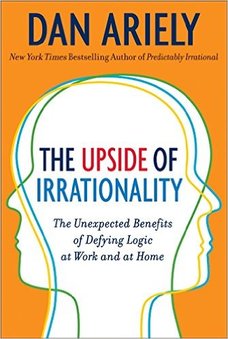 The Upside of Irrationality: The Unexpected Benefits of Defying Logic at Work and at Home by Dan Ariely, Harper, 2010. Go to Ariely’s website to read more about him and his work. I have linked specifically to his pages on this book.
The Upside of Irrationality: The Unexpected Benefits of Defying Logic at Work and at Home by Dan Ariely, Harper, 2010. Go to Ariely’s website to read more about him and his work. I have linked specifically to his pages on this book.
You can read two previous posts (here and here–for some reason the entire text of the first one did not get published, but you can get the gist from what’s there) on this whole idea of self-sufficiency. Knowing that you can fix, clean, build, or cook something yourself, and then actually doing it, is profoundly satisfying, even if what you do yourself isn’t as good of a job as something a professional could do. I’m sure that a paid landscape crew could do a much better job of maintaining my flowerbeds and vegetable garden than I do, but that’s not the point. I enjoy working in the yard; I want to go outside and get sweaty and dirty rather than sitting inside and watching somebody else do the work. Ariely titles his chapter on this phenomenon “The IKEA Effect” and tells the amusing story of the aforementioned toy chest: “I was very proud of my work, and for weeks afterward I smiled proudly at my creation each time I passed it. From an objective point of view, I am quite sure that it was not the highest-quality piece of furniture I could have purchased” (p. 84, 2010 hardback edition).
This idea of so-called “voluntary hardship” is referenced quite a bit over on the Mr. Money Mustache blog. most notably in his post about the exertions it took to install the heating system in his new house. He had to lie on his back under the house, dressed in protective clothing, wearing eye gear, earplugs, and a headlamp, wrestling with the piping for his under-floor radiant heat system. He could only work for two hours at a time, but, as he says, “The physical and mental benefits of crawling and sweating and fighting with stubborn tools and materials for so many hours are incomparable.” There’s an enormous sense of accomplishment in doing a tough job yourself; in fact, there’s usually a real sense of letdown when the project is finished, which is why it’s so important to have the next project in mind before you finish the current one. Sounds exhausting, doesn’t it? And we do need down times, but those times are valuable only as they stand in contrast to our exertions.
Such a fascinating topic, the human drive to accomplish, to meet goals. “Doing it yourself” is sure to show up again on this blog.